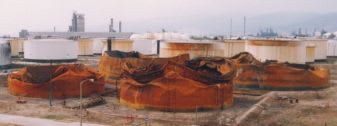I found that in IP
The first priority should be to decide whether a water deluge/spray system is needed. Typically, this will require consideration of the local legislative
position as well as fully appraising the risk. The most appropriate method is to carry out a scenario-based evaluation of credible fire incidents. For example, a single small tank, where options exist for rapid deployment of portable fire-fighting equipment may not necessitate the use of such a fixed system. However, a large tank within a bund with minimal separation and significant fire exposure potential might benefit from fixed water-cooling.
One method of determining whether fixed watercooling might be required is to make use of validated fire consequence modeling software packages to
determine the extent of radiant heat flux on a given tank or part of an installation. Generally, fixed water-cooling should be considered if the exposed tank, vessel or plant is likely to be exposed to a radiant heat flux in excess of 32 kW/m2 (see section 2.6.2).
Where exposures are likely to be subjected to less than this amount – typically 8 kW/m2 and above – fixed water-cooling may be considered, but may not always
be necessary. Generally, cooling will be required at some stage but this may be provided by mobile means (e.g. with the use of portable water monitors – portable and mobile fire response issues are outlined in section 7.6.1). Cooling water

